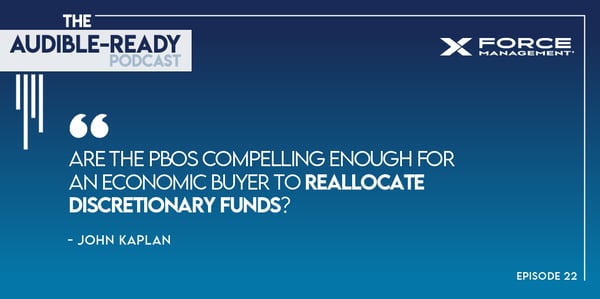
Three Ways to Improve Your Sales Messaging
Categories: Sales Conversation
Nothing moves a deal forward like a sales conversation that’s focused on the fundamentals. If you want to command your message, you need to practice and zero-in on the basics, consistently.
Moving opportunities forward and closing them at high-value — are two critical areas even veteran sellers are struggling with right now. Improve your sales messaging and minimize risks to your forecasted deals with this quick refresher of three things to remember every time you make a sales call:
1. Positive Business Outcomes
Positive Business Outcomes (PBOS) are the tangible benefits that result from a buyer implementing your solutions. One of the most common reasons deals stall is when sales reps aren’t attached to these desired outcomes and the biggest business issues facing their buyers.
If you can get your prospects to stand in their moment of pain and articulate PBOs that will get them out of that pain — your deals will propel forward. When you are preparing for your sales conversation, ask yourself these questions:
- Do the PBOs identified address business-level goals or are they lower level in nature?
- Are these PBOs compelling enough for an economic buyer to re-allocate discretionary funds?
If the answer to either is “No”, go back and dig deeper by:
- Playing back your discovery sessions with buyers
- Focusing on the right questions and using them to get your buyer to share high-level business problems that indicate urgency
- Ensuring you’re working with a champion, and are aligned to the economic buyer versus someone lower in the organization who may have more technical, lower-level issues and no access to discretionary funds

2. Required Capabilities
Required capabilities define the specific requirements that are necessary to achieve your prospect's PBOs. Required capabilities are the essence of their decision criteria, meaning if your buyers want to achieve X, they need to make sure Y is in place. The PBOs and the Required Capabilities are where the technical and business worlds come together. As an elite seller you’ve got to nail the two and connect them. You can’t just move forward with one or the other — or your deal will stall or lose to competition or a no decision.
As you assess your deals for alignment between PBOs and required capabilities, consider these questions:
- Do the required capabilities describe the minimum requirements that are necessary to move the customer from the Before to the After Scenario?
- Are they compelling enough for your buyer to take the next step, versus come to a “no decision” or a “do nothing”?
- Have you explained how your offerings satisfy the required capabilities in a way that is superior, or significantly different than the competition – and in a way that has meaning to the customer?
Elite sellers develop the required capabilities with their buyers in a way that favors their solutions. More often than not, a buyer will have a desired future state, but not necessarily a defined way to get there. The most elite sellers leverage this gap by guiding their buyers in defining their own decision criteria, and in doing so, influencing that criteria with their solution's competitive differentiators.
They use trap-setting questions to trap the competition around your differentiators, because, if your differentiators become part of the decision criteria, you’ve got a good shot at winning the deal. Improve your ability to compete by getting familiar with effective ways to ask trap-setting questions and keep track of what works and what doesn’t.
3. Metrics
Metrics define how your customer will measure success. They establish the key performance indicators (KPIs) that define how success will be measured once the solution is implemented.
In many of our Command of the Message® engagements, salespeople and front-line managers continually mention having difficulty defining the metrics in a sales conversation. The best advice we have for them is, “don’t overcomplicate it!”
In any business engagement, key decision makers don’t get involved with anything without measuring success. In a value-based conversation, metrics are the way you measure required capabilities and PBOs, but they’re not the whole story. Know your proof points in-and-out and leverage them to keep conversations on metrics simple, tangible and focused on the big picture.
Putting evidence behind your claims of how you’re better than the competition helps your buyers see the positive business outcomes in situations similar to theirs. They can also influence the decision criteria. Here’s our best advice on how to maximize the effectiveness of your proof points and leverage testimonials in sales conversations.
Hear More Strategies You Can Use to Improve Your Win Rates:
In a murky sales environment it can be easy to lose motivation or get sidetracked. Even the most effective sellers can get complacent. Spend a few minutes each week recharging your sales game and focusing on the fundamentals. Subscribe to the Audible-Ready Podcast on your favorite streaming platform. We share weekly, quick episodes that cover timely sales tactics that you can apply to live deals and improve your ability to hit your number.
Do you want more tips from B2B sales pros? Learn more about Ascender by Force Management. Content, Curriculum, Community.


